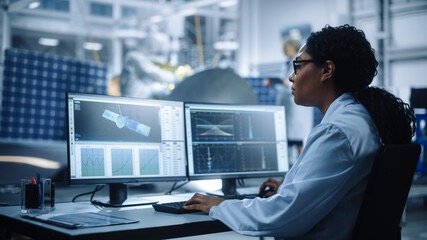WHO IS THIS FOR?
The Satellite Engineering Specialist (SES) certification is designed for:
Satellite Engineers & Space Systems Developers: Professionals responsible for designing, integrating, and testing satellite components.
Military & Defense Personnel: Service members specializing in satellite operations, space systems engineering, and payload integration (e.g., Air Force 13S, Space Force satellite operations, Army FA40, Navy Space Cadre).
Aerospace & Defense Contractors: Engineers and analysts working on satellite payloads, communication systems, and propulsion technologies.
Spacecraft Systems & Payload Engineers: Specialists managing power, thermal, and attitude control systems for satellite missions.
Telecommunications & RF Engineers: Professionals working on satellite communications, link budgets, and onboard RF systems.
Students & Early-Career Professionals: Individuals pursuing careers in satellite engineering, space mission design, and spacecraft systems integration.
ELIGIBILITY
The Satellite Engineering Specialist (SES) certification is designed for professionals working with satellite subsystems, integration, and testing. Ideal candidates must:
Verify they fit one of the “who is this for” categories.
Meet U.S. Export Control requirements (Must be a U.S. Person).
Be able to understand, read, and write in U.S. English without interpreters or translators.
Operate a computer for email, browsing, logging in, Zoom or similar, and other basic functions.
Own or have access to a desktop or tablet computer with internet access, a front-facing camera, and a microphone in a quiet area for completing exams.
CERTIFICATION STANDARDS
1. Fundamentals of Satellite Engineering
1.1. Define key satellite subsystems and their interdependencies.
1.2. Explain satellite mission design considerations for LEO, MEO, and GEO orbits.
1.3. Identify spacecraft structural requirements, materials, and thermal management techniques.
2. Satellite Payloads & Communication Systems
2.1. Explain satellite payload types, including communication, Earth observation, and scientific instruments.
2.2. Describe RF system design for satellite communication payloads.
2.3. Identify key parameters for satellite antenna design and frequency allocation.
3. Satellite Propulsion Systems
3.1. Define chemical, electric, and hybrid propulsion technologies for satellites.
3.2. Explain station-keeping, orbital maneuvering, and end-of-life disposal strategies.
3.3. Identify fuel efficiency and thrust optimization techniques for deep-space missions.
4. Attitude Determination & Control Systems (ADCS)
4.1. Explain reaction wheels, control moment gyroscopes (CMGs), and magnetorquers.
4.2. Identify star trackers, gyroscopes, and sun sensors for attitude determination.
4.3. Describe closed-loop control techniques for precise satellite orientation.
5. Power Systems & Energy Storage
5.1. Define satellite power generation methods, including solar arrays and radioisotope thermoelectric generators (RTGs).
5.2. Explain battery storage and power management strategies for space applications.
5.3. Identify spacecraft electrical distribution and fault tolerance techniques.
6. Thermal Control Systems
6.1. Describe active and passive thermal control methods for spacecraft.
6.2. Explain heat dissipation strategies for electronics and propulsion systems.
6.3. Identify insulation and radiator technologies for extreme space environments.
7. Spacecraft Integration & Testing
7.1. Define key integration procedures for satellite subsystems.
7.2. Explain environmental testing standards, including vibration, thermal vacuum, and radiation tests.
7.3. Identify validation methods for spacecraft before launch deployment.
8. Spacecraft Command & Data Handling (C&DH)
8.1. Describe satellite onboard computing and data processing architectures.
8.2. Explain telemetry, tracking, and command (TT&C) operations.
8.3. Identify fault detection and autonomous recovery strategies for spacecraft.
9. Emerging Technologies & Future Trends in Satellite Engineering
9.1. Explain AI and machine learning applications in satellite automation.
9.2. Describe small satellite (CubeSat) architectures and their advantages.
9.3. Identify quantum communication and next-generation satellite network innovations.
RELEVANT MILITARY JOB CODES
The Satellite Engineering Specialist (SES) certification aligns with military roles specializing in satellite systems engineering, payload integration, and spacecraft operations. Relevant military job codes include:
13S – Air Force Space Operations Officer
FA40 – Army Space Operations Officer
Space Force Satellite & Space Systems Engineering Roles
Navy Space Cadre Officers & Engineers
Aerospace & Defense Engineers in Satellite Development & Integration
This certification is valuable for satellite engineers, spacecraft systems specialists, and defense contractors working on spacecraft design, integration, and mission readiness across commercial, military, and scientific space missions.
